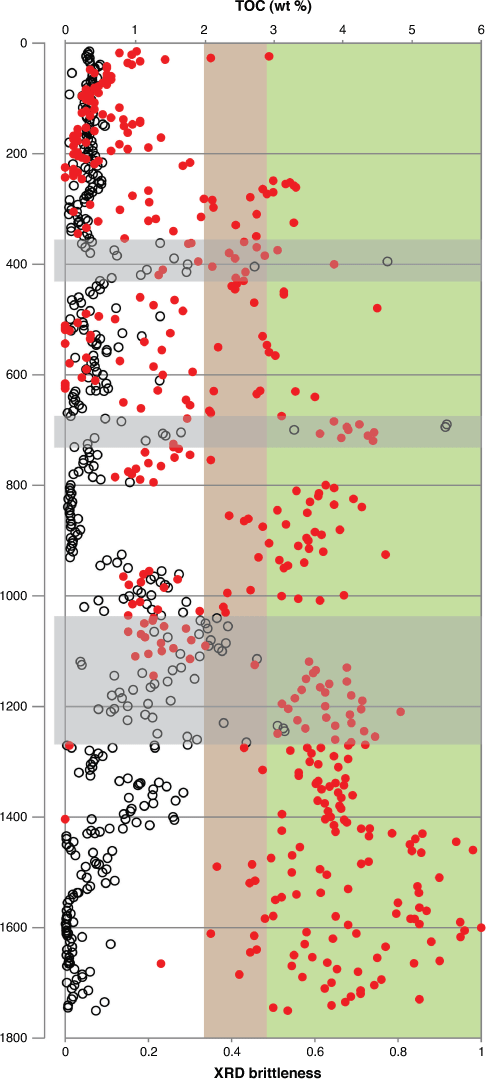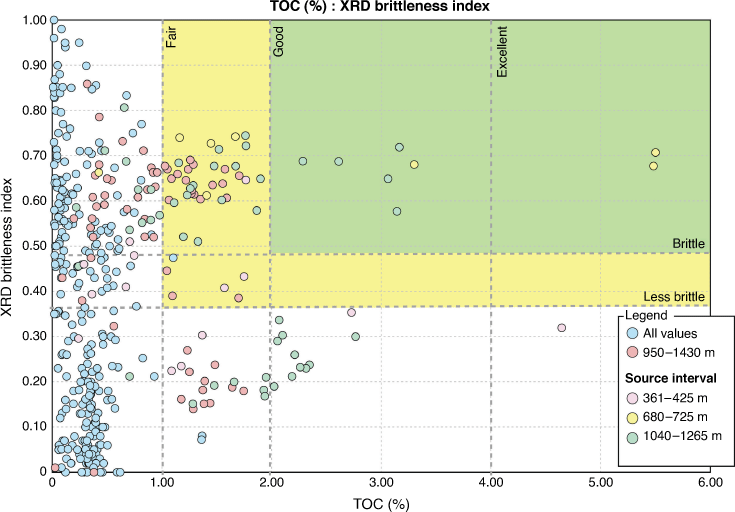Resource potential of the Carrara Sub-basin from the deep stratigraphic well NDI Carrara 1
A. H. E. Bailey A * , E. Grosjean A , L. Wang A , C. J. Boreham A , G. A. Butcher A , C. J. Carson A , A. J. M. Jarrett B , L. K. Carr A , C. Southby A , T. J. Palu A and P. A. Henson AA Geoscience Australia, Canberra, ACT, Australia.
B Northern Territory Geological Survey, Darwin, NT, Australia.
The APPEA Journal 62 S378-S384 https://doi.org/10.1071/AJ21075
Accepted: 8 March 2022 Published: 13 May 2022
© 2022 The Author(s) (or their employer(s)). Published by CSIRO Publishing on behalf of APPEA. This is an open access article distributed under the Creative Commons Attribution 4.0 International License (CC BY).
Abstract
NDI Carrara 1 is a deep stratigraphic well completed in 2020 as part of the MinEx CRC National Drilling Initiative (NDI), in collaboration with Geoscience Australia and the Northern Territory Geological Survey. It is the first stratigraphic test of the Carrara Sub-basin, a newly discovered depocentre in the South Nicholson Region. The well intersected Proterozoic sediments with numerous hydrocarbon shows, likely to be of particular interest due to affinities with the known Proterozoic plays of the Beetaloo Sub-basin and the Lawn Hill Platform, including two organic-rich black shales and a thick sequence of interbedded black shales and silty-sandstones. Alongside an extensive suite of wireline logs, continuous core was recovered from 283.9 m to total depth at 1750.8 m, providing high-quality data to support comprehensive analysis. Presently, this includes geochronology, geochemistry, geomechanics and petrophysics. Rock-Eval pyrolysis data demonstrate the potential for several thick black shales to be a source of hydrocarbons for conventional and unconventional plays. Integration of these data with geomechanical properties highlights potential brittle zones within the fine-grained intervals where hydraulic stimulation is likely to enhance permeability, identifying prospective Carrara Sub-basin shale gas intervals. Detailed wireline log analysis further supports a high potential for unconventional shale resources. Interpretation of the L210 and L212 seismic surveys suggests that the intersected sequences are laterally extensive and continuous throughout the Carrara Sub-basin, potentially forming a significant new hydrocarbon province and continuing the Proterozoic shale play fairway across the Northern Territory and northwest Queensland.
Keywords: Carrara Sub-basin, Egilabria, Exploring for the Future, EFTF, Lawn Hill Formation, Lawn Supersequence, McArthur Basin, MinEx CRC, NDI Carrara 1, organic content, organic-rich shales, Proterozoic shales, rock properties, shale brittleness, shale gas, South Nicholson Region, TOC.
Introduction
The Australian Government’s Exploring for the Future (EFTF) program launched in 2016 with A$100.5 million of funding provided to Geoscience Australia to explore Australia’s resource potential and boost investment in northern Australia. In 2020 an additional A$125 million of funding, spread over 4 years to 2024, was announced to expand the program nationwide. The EFTF energy component aims to attract industry investment by delivering a suite of new precompetitive geoscience data and knowledge of the oil and gas prospectivity of Australian sedimentary basins. One of the initial study areas was the Paleo- to Mesoproterozoic South Nicholson Region (Carr et al. 2020; Jarrett et al. 2020) of Queensland and the Northern Territory, where Geoscience Australia acquired extensive new precompetitive geological datasets; most notably the 2017 L210 and the 2019 L212 reflection seismic surveys. These seismic surveys imaged thick sedimentary successions that are directly correlatable to the known oil and gas plays in northwest Queensland’s northern Lawn Hill Platform. To provide stratigraphic control and further understand the successions imaged by the seismic, the NDI Carrara 1 drill hole was completed in 2020 as a partnership between Geoscience Australia, MinEX CRC and the Northern Territory Geological Survey (NTGS).
NDI Carrara 1 was drilled within the Northern Territory, about 250 km north west of Mount Isa, in the Carrara Sub-basin – a new depocentre revealed by the L210 South Nicholson Deep Crustal Seismic Survey (Carr et al. 2020; Jarrett et al. 2020). The well is a collaboration between the MinEx CRC National Drilling Initiative (NDI), Geoscience Australia and the Northern Territory Geological Survey. Drilled to a total depth of 1750.8 mRT, the well penetrated a succession of Cambrian-age carbonate and siliciclastic rocks assigned to the Georgina Basin before intersecting a thin section of potentially Mesoproterozoic South Nicholson Group sediments that unconformably overly a succession of potentially Paleoproterozoic-age siliclastic and carbonate-rich sediments. Although drilled off structure, there were numerous hydrocarbon shows within both the Cambrian and the Paleoproterozoic intervals. Bitumen was observed within core vugs between 528.3 and 528.6 mRT, and several oil stains were observed in association with fractures and carbonate veins between 763 and 769 mRT. Notable levels of gas, up to 2% (or 2000 units), were recorded in association with black Paleoproterozoic shales. This gas consisted primarily of methane with trace ethane, propane and butane. Ditch cuttings were recovered from surface to 283.9 mRT, with continuous core acquired from 283.9 to TD at 1750.8 mRT. Two stages of wireline logging were conducted and included both open-hole and cased-hole logs for formation evaluation. The well was then plugged and decommissioned (Carson et al. 2021).
Discussion
Geoscience Australia has worked with partners to undertake a comprehensive analysis program, including geochronology, geochemistry, geomechanics and petrophysics, to understand the resource potential of the Proterozoic Carrara Sub-basin. Analysis focused primarily on rock samples acquired from the recovered core and cuttings. A total of 438 samples were collected approximately every 4 m downhole, and were processed according to the procedure described in Butcher et al. (2021). Additional samples have since been taken for further investigation. Details of these samples, planned analyses and available results can be found at https://www.ga.gov.au/eftf/projects/barkly-isa-georgetown/south-nicholson-national-drilling-initiative.
Geochemistry
Rock-Eval pyrolysis was performed on 417 samples, including 87 cuttings from 15 to 284 m and 330 core samples from 284 to 1750.8 m, to assess the hydrocarbon-generation potential of Carrara Sub-basin sediments. The data from these analyses are reported in Butcher et al. (2021) and are discussed in Grosjean et al. (2022).
Several organic-rich sections are identified within both the Cambrian and the Proterozoic intervals. In the Cambrian, organic-rich marls are identified from 361 to 425 m, with total organic carbon (TOC) of up to 4.7 wt% and Hydrogen Index (HI) values greater than 300 mg/gTOC, indicating the presence of an excellent source rock with potential for oil generation. Tmax values range from 406 to 442°C for the Cambrian section, indicating an immature to peak mature level of thermal maturity for oil generation (Butcher et al. 2021). Two significant organic-rich intervals are present in the Proterozoic interval, which preliminary geochronology results suggest may be genetically related to known northern Australian Proterozoic shales in the northern Lawn Hill Platform and Beetaloo Sub-basin. Black mudstones between 680 and 725 m have TOC of up to 5.5 wt% (mean TOC = 2.0 wt%) with a mean associated HI of 80 mg/gTOC, implying that these rocks may have some remaining-gas-generation potential (Table 1). A thick interval of interbedded micrites and shales from 950 to 1430 m demonstrates good organic richness, with a mean TOC of 1.2 wt%. However, HI is very low with a mean value of 2 mg/gTOC, implying that this interval retains no present-day generative potential. Within this organic-rich interval is a unit, dominated by black shales, with TOC of up to 3.2 wt% and a mean value of 1.6 wt% from 1040 to 1265 m (Table 1). This unit features several intervals with TOC >2.0 wt% (Butcher et al. 2021) that are likely to have the highest potential as a source rock and unconventional play.

|
Rock properties
X-ray diffraction (XRD) analyses were undertaken on the same sample set that was sub-sampled for the Rock-Eval pyrolysis, discussed above. In total, 420 samples were analysed via quantitative XRD (qXRD) including 33 cuttings and 333 core samples, and provided bulk mineralogy of samples with identification of 18 mineral groups, with one extra group for unknown minerals where diffraction peaks could not be identified (Carson et al. 2022).
The mechanical properties of shale reservoirs, such as strength, plasticity, brittleness and elasticity, are often a function of mineralogy (Jarvie et al. 2007; Sone and Zoback 2013; Perez Altamar and Marfurt 2014). Accurately identifying brittle intervals in organic-rich shales is essential in understanding and developing shale reservoirs. While shale reservoirs are capable of generating and trapping vast quantities of hydrocarbons, extremely low permeabilities can yield very limited gas flow unless a large volume of the reservoir can be connected to a wellbore through hydraulic stimulation (Jarvie et al. 2007; Perez Altamar and Marfurt 2014). Brittle rocks are incapable of supporting large quantities of strain and will fail, creating structural permeability pathways when stimulated (Saldungaray and Palisch 2012; Perez Altamar and Marfurt 2014). Brittleness Index (BI) is a proxy for rock strength and, hence, provides insight into stimulation effectiveness (Jarvie et al. 2007; Gray et al. 2012). However, the utility of BI as an indicator of rock properties has been discussed (e.g. Sone and Zoback 2013; Herwanger et al. 2015; Mathia et al. 2016; Zhang et al. 2017; Tenthorey and Ayling 2021) and in many cases BI is a successful indicator of rock strength. Conversely, there are examples where BI does not exhibit any relationship with rock strength and is not correlated with effective reservoir stimulation (e.g. Mathia et al. 2016). Hall (2019) demonstrates that understanding depositional and diagenetic processes is essential to fully comprehending the relationship between mineralogy and brittleness. However, in basins with limited data availability BI is a useful and cost effective tool for identifying zones of interest over a large area.
Numerous methods for calculating BI exist, though the most commonly used is the Jarvie et al. (2007) relationship based on mineralogy as it is both simple and reproducible:

BI is calculated as a value from 0 to 1 and shales are typically characterised as ductile when BI < 0.16, less ductile when BI = 0.16–0.32, less brittle when BI = 0.32–0.48 and brittle when BI > 0.48 (Perez Altamar and Marfurt 2014). Using Eqn 1, BI was calculated from the NDI Carrara 1 qXRD data. The results are presented in Fig. 1, and summarised in Table 2 for the potential source intervals previously identified.

|

|
Bailey et al. (in press) present a workflow for identifying potential shale gas target intervals using TOC data and BI to identify organic-rich intervals that are likely to respond favourably to hydraulic stimulation. In order to gauge the utility of BI values calculated in the Carrara Sub-basin, Geoscience Australia has used this process to assist in identifying intervals within NDI Carrara 1 that may form potential shale gas intervals. This work will, in part, guide the selection of further samples which will be subjected to detailed geomechanical analysis to constrain mechanical and elastic properties.
Fig. 1 demonstrates that the potential source intervals in the Proterozoic section (680‒7725 and 1040‒1265 m) are also likely to be brittle, with mean BI values over those intervals of 0.65 and 0.48, respectively (Table 2). Fig. 2 presents a crossplot of the TOC and XRD-derived BI, which further illustrates the presence of brittle rocks with TOC ≥ 2.0 wt%.
Summary and conclusions
The recently drilled deep stratigraphic well NDI Carrara 1 is the first intersection of the Carrara Sub-basin, a frontier province with potential genetic ties to the known Proterozoic shale plays of the northern Lawn Hill Platform and the Beetaloo Sub-basin. The well recovered cuttings and core samples for the entire length of the well, and these are currently the focus of an extensive analysis program by Geoscience Australia and partners. Organic geochemistry highlights the presence of several organic-rich intervals within both the Proterozoic section and the overlying Cambrian interval. Preliminary geochronology results imply that the Proterozoic section, which contains two organic-rich black shale intervals with elevated TOC at the depth range of 680–725 and 1040–1265 mRT, may be related to known northern Australian Proterozoic shales. Calculation of brittleness indices from qXRD data demonstrates that these two shale intervals are likely to be brittle and, hence, hydraulic stimulation is likely to enhance permeability. These data imply that these black shales may form potential shale gas plays within the Carrara Sub-basin; additional analyses are being undertaken by Geoscience Australia to further understand these rocks and their prospectivity. Interpretation of regional, deep-crustal seismic lines suggests that these potential shale gas plays are laterally extensive and continuous throughout the Carrara Sub-basin, potentially forming a significant new hydrocarbon province and continuing the Proterozoic shale play fairway across the Northern Territory and northwest Queensland.
Data availability
The data that support this study are available in Geoscience Australia’s catalogue at https://ecat.ga.gov.au/geonetwork/srv/eng/catalog.search#/home.
Conflicts of interest
All authors confirm that there are no conflicts of interest.
Declaration of funding
This research was funded through the Australian Government Exploring for the Future program, led by Geoscience Australia.
Acknowledgements
Geoscience Australia would like to acknowledge our collaborators, the MinEx CRC National Drilling Initiative and the Northern Territory Geological Survey (NTGS). The authors thank Darryl Stacey (NTGS), Amber Jarrett (NTGS) and Arvid Buskas (Northern Geological Consultants) for their work in sampling the NDI Carrara 1 core on our behalf, and the NTGS for facilitating this activity. Thanks also go to Geoscience Australia’s Organic Geochemistry and Isotope Laboratory team for their work in preparing and analysing samples, and the Minerals, Energy and Groundwater Division Information Management team for management of data. The authors would particularly like to thank Eric Tenthorey and Stephanie Rees for their internal peer review and Grace Butcher and Aziah Williamson (Geoscience Australia) for their assistance with samples. This extended abstract is published with the permission of the CEO, Geoscience Australia. eCat 146297.
References
Bailey AHE, Jarrett AJM, Wang L, Reno B, Tenthorey E, Carson CJ, Henson PA (in review) Shale Brittleness within the Paleoproterozoic Isa Superbasin Succession in the South Nicholson Region, Northern Australia. Australian Journal of Earth Sciences.Butcher G, Grosjean E, Jarrett AJM, Boreham CJ, Jinadasa N, Webster T, Hong Z, Carson CJ (2021) Exploring for the Future – Rock-Eval Pyrolysis Data from NDI Carrara 1, South Nicholson Region, Australia. Geoscience Australia, Canberra.
Carr LK, Southby C, Henson P, Costello R, Anderson J, Jarrett AJM, Carson C, Gorton J, Hutton L, Troup A, Williams B, Khider K, Bailey A, Fomin T (2020) Exploring for the Future: South Nicholson Basin Seismic Interpretation. Geoscience Australia, Canberra.
Carson C, Wang L, Carr L, Jarrett AJM, Bailey AHE, Grosjean E, Boreham C, Edwards DS, Anderson J, Southby C, Khider K, MacFarlane SK, Edgoose CJ, Close D, Henson P (2021) Borehole completion report – NDI Carrara 1. Available at https://portal.ga.gov.au/bhcr/minerals/648482 [Accessed 1 February 2022]
Carson CJ, Grosjean E, Butcher G, Webber S, Gilmore S, Henson PA (2022) Exploring for the future – quantitative X-ray diffraction data release of NDI Carrara 1, South Nicholson Region, Northern Territory. Destructive Analysis Report. Number Record 2022/005. Geoscience Australia, Canberra.
| Crossref |
Gray D, Anderson P, Logel J, Delbecq F, Schmidt D, Schmid R (2012) Estimation of stress and geomechanical properties using 3D seismic data. First Break 30, 59–68.
| Estimation of stress and geomechanical properties using 3D seismic data.Crossref | GoogleScholarGoogle Scholar |
Grosjean E, Jarrett AJM, Boreham CJ, Butcher G, Carson C, Bailey AHE, Wang L, Henson P (2022) The energy resource potential of the Carrara Sub-basin revealed by new stratigraphic drilling. In Annual Geoscience Exploration Seminar (AGES), Alice Springs (AIG: Crows Nest, NSW).
Hall CD (2019) Compositional and Diagenetic Controls on Brittleness in Organic Siliceous Mudrocks. In ‘AAPG Memoir 120: Mudstone Diagenesis: Research Perspectives for Shale Hydrocarbon Reservoirs, Seals, and Source Rocks’. (Eds WK Camp, KL Milliken, K Taylor, N Fishman, PC Hackley, JHS Macquaker) pp. 103–120. (AAPG).
| Crossref |
Herwanger JV, Bottrill AD, Mildren SD (2015) Uses and abuses of the brittleness index with applications to hydraulic stimulation. Paper presented at the SPE/AAPG/SEG Unconventional Resources Technology Conference, San Antonio, Texas, USA, July 2015.
| Crossref |
Jarrett AJM, Bailey AHE, Carr LK, Anderson JR, Palu TJ, Carson CJ, Boreham C, Southby C, MacFarlane SK, Hall LS, Bradshaw B, Orr M, Munson T, Williams B, Simmons J, Close D, Edwards S, Troupe A, Gorton J, Gunning M, Henson P (2020) A Multidisciplinary Approach to Improving Energy Prospectivity in the South Nicholson Region. Geoscience Australia, Canberra.
Jarvie DM, Hill RJ, Ruble TE (2007) Unconventional shale-gas systems: the Mississippian Barnett Shale of north-central Texas as one model for thermogenic shale-gas assessment. AAPG Bulletin 91, 475–499.
| Unconventional shale-gas systems: the Mississippian Barnett Shale of north-central Texas as one model for thermogenic shale-gas assessment.Crossref | GoogleScholarGoogle Scholar |
Mathia E, Ratcliffe K, Wright M (2016) Brittleness index-a parameter to embrace or avoid? Paper presented at the SPE/AAPG/SEG Unconventional Resources Technology Conference, San Antonio, Texas, USA, August 2016.
| Crossref |
Perez Altamar R, Marfurt K (2014) Mineralogy-based brittleness prediction from surface seismic data: application to the Barnett Shale. Interpretation 2, T255–T271.
| Mineralogy-based brittleness prediction from surface seismic data: application to the Barnett Shale.Crossref | GoogleScholarGoogle Scholar |
Saldungaray PM, Palisch TT (2012) Hydraulic fracture optimization in unconventional reservoirs. Paper presented at the SPE Middle East Unconventional Gas Conference and Exhibition, Abu Dhabi, UAE, January 2012.
| Crossref |
Sone H, Zoback MD (2013) Mechanical properties of shale-gas reservoir rocks—Part 2: ductile creep, brittle strength, and their relation to the elastic modulus. Geophysics 78, D393–D402.
| Mechanical properties of shale-gas reservoir rocks—Part 2: ductile creep, brittle strength, and their relation to the elastic modulus.Crossref | GoogleScholarGoogle Scholar |
Tenthorey E, Ayling B (2021) Geomechanical evaluation of a Middle Cambrian unconventional oil and gas play in the Southern Georgina Basin, Northern Australia. Australian Journal of Earth Sciences 68, 697–716.
| Geomechanical evaluation of a Middle Cambrian unconventional oil and gas play in the Southern Georgina Basin, Northern Australia.Crossref | GoogleScholarGoogle Scholar |
Zhang C, Dong D, Wang Y, Guan Q (2017) Brittleness evaluation of the Upper Ordovician Wufeng–Lower Silurian Longmaxi Shale in Southern Sichuan Basin, China. Energy Exploration & Exploitation 35, 430–443.
| Brittleness evaluation of the Upper Ordovician Wufeng–Lower Silurian Longmaxi Shale in Southern Sichuan Basin, China.Crossref | GoogleScholarGoogle Scholar |

Adam H. E. Bailey is a Petroleum Geoscientist at Geoscience Australia, with expertise in petroleum geomechanics, structural geology and basin analysis. He graduated with a BSc (Hons) in 2012 and a PhD in 2016 from the Australian School of Petroleum at the University of Adelaide. Adam is currently part of the Onshore Energy Systems team at Geoscience Australia, where he is working on the flagship Exploring for the Future program in Northern Australia. |

Emmanuelle Grosjean is an Organic Geochemist at Geoscience Australia, working in the Minerals, Energy and Groundwater Division. Emmanuelle applies organic geochemistry to assess the hydrocarbon prospectivity of Australia’s offshore and onshore sedimentary basins. Emmanuelle holds a PhD in Organic Chemistry from the University of Strasbourg, France. Before joining Geoscience Australia in 2005, she worked on the Precambrian petroleum systems of the South Oman Salt Basin as a Post-doctoral Associate at the Massachusetts Institute of Technology. |

Dr Liuqi Wang is a well analyst at Geoscience Australia working in the Minerals, Energy and Groundwater Division. He received his PhD in Petroleum Engineering and worked as a Research Fellow at the University of New South Wales before joining Geoscience Australia. His research interests include petrophysics, static and dynamic reservoir modelling, applied statistics and artificial intelligence. He is a member of PESA and EAGE. |

Christopher J. Boreham is a principal petroleum geochemist at Geoscience Australia working in the Minerals, Energy and Groundwater Division. He obtained his BSc (Hons) in Chemistry from the University of Queensland and awarded a PhD in Chemistry at ANU. He has worked at Geoscience Australia for four decades. Chris has a wide experience in the application of organic geochemistry to the evolution of oil and gas in Australian sedimentary basins. He has recently extended these geochemical studies to unconventional petroleum (coal seam methane, shale gas and oil), helium, hydrogen and abiogenic hydrocarbons, as well as being involved in CO2CRC’s studies on the injection of CO2 into a depleted natural gas field and a saline aquifer. In 2010 he received the Australian Organic Geochemistry Conference Medal for lifetime achievement in the field of Organic Geochemistry. Chris is a member of PESA and AAPG. |

Grace Butcher is a Geologist at Geoscience Australia. She Graduated with a BSc (Hons) in 2010 from the School of Earth and Environment at the University of Leeds. Working with the Onshore Energy Systems team at Geoscience Australia. Grace is currently working on the flagship Exploring for the Future program in Northern Australia, specifically the NDI Carrara 1 drill hole and newly discovered Carrara Sub-basin. |

Chris Carson has worked in Antarctica, Canadian Arctic, Alaska, New Caledonia and northern and central Australia, specialising in metamorphic petrology, geochronology and structural geology. Joining Geoscience Australia in 2006, he dabbled in SHRIMP geochronology and, in 2017, joined the Onshore Energy program, working in the South Nicholson Region of the NT. |

Dr Amber J. M. Jarrett is a Geochemist working in the Basin Systems section at the Northern Territory Geological Survey. Prior to this, she worked for 7 years in the Minerals, Energy and Groundwater Division at Geoscience Australia. Her research interests include basin-hosted resource potential, organic–inorganic geochemistry, isotopes, Proterozoic biomarkers and early life. Amber graduated with a BSc (Hons), with a major in Geology and Biology, in 2008 and a PhD in 2014 from the Australian National University. Amber is also a key researcher in the MinExCRC. |

Lidena Carr is a Geoscientist for the Onshore Energy Systems Directorate, Basins Systems Branch, Minerals, Energy and Groundwater Division at Geoscience Australia. She graduated from the Australian National University with a BA/BSc (Hons) in 2004, with a major in Geology and Human Ecology. In 2007, she joined Geoscience Australia and then ACRES (satellite imagery), before moving to her current position as a Seismic Interpreter and Basin Analyst. She currently works within the Exploring for the Future program and is a member of GSA. |

Chris Southby is a Geoscientist in the Geoscience Australia Resources Division, Energy Systems Branch. He completed his Honours at ANU in 2004 on Palaeo-climate Geochemistry of Corals from Papua New Guinea. Since joining Geoscience Australia in 2008, he has contributed to a number of projects, including the National Carbon Mapping and Infrastructure Plan, the Vlaming Sub-basin CO2 Storage Assessment and the Houtman Sub-basin Prospectivity Project. He is now part of the Onshore Energy Systems team at Geoscience Australia, currently working under the Exploring for the Future program initiative. |

Tehani Palu is a Geoscientist in the Onshore Energy Systems section in the Resources Division at GA. She gained her master’s degree from the University of Waikato (New Zealand) in 2009 and joined GA shortly after completing her studies. Tehani has been in her present role since 2013, which sees her doing basin analysis and petroleum systems modelling within the energy systems branch. She is a member of PESA. |

Paul A. Henson graduated from the University of Tasmania and is currently the Director of the Onshore Energy Systems section at Geoscience Australia. He has extensive experience in the minerals sector working on mineral systems in Proterozoic and Archaean terranes. Since 2010, he has led the Australian Governments’ Onshore Carbon Storage Program, undertaking deep onshore drilling and seismic acquisition programs in collaboration with the states and industry. He now manages the EFTF Energy program leading to a team of researchers to acquire new precompetitive geoscientific data to improve our understanding of the oil and gas potential of Australian onshore basins. |



